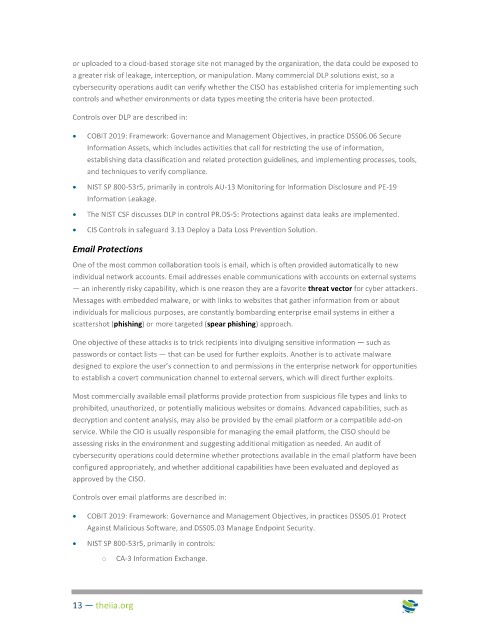Page 181 - ITGC_Audit Guides
P. 181
or uploaded to a cloud-based storage site not managed by the organization, the data could be exposed to
a greater risk of leakage, interception, or manipulation. Many commercial DLP solutions exist, so a
cybersecurity operations audit can verify whether the CISO has established criteria for implementing such
controls and whether environments or data types meeting the criteria have been protected.
Controls over DLP are described in:
COBIT 2019: Framework: Governance and Management Objectives, in practice DSS06.06 Secure
Information Assets, which includes activities that call for restricting the use of information,
establishing data classification and related protection guidelines, and implementing processes, tools,
and techniques to verify compliance.
NIST SP 800-53r5, primarily in controls AU-13 Monitoring for Information Disclosure and PE-19
Information Leakage.
The NIST CSF discusses DLP in control PR.DS-5: Protections against data leaks are implemented.
CIS Controls in safeguard 3.13 Deploy a Data Loss Prevention Solution.
Email Protections
One of the most common collaboration tools is email, which is often provided automatically to new
individual network accounts. Email addresses enable communications with accounts on external systems
— an inherently risky capability, which is one reason they are a favorite threat vector for cyber attackers.
Messages with embedded malware, or with links to websites that gather information from or about
individuals for malicious purposes, are constantly bombarding enterprise email systems in either a
scattershot (phishing) or more targeted (spear phishing) approach.
One objective of these attacks is to trick recipients into divulging sensitive information — such as
passwords or contact lists — that can be used for further exploits. Another is to activate malware
designed to explore the user’s connection to and permissions in the enterprise network for opportunities
to establish a covert communication channel to external servers, which will direct further exploits.
Most commercially available email platforms provide protection from suspicious file types and links to
prohibited, unauthorized, or potentially malicious websites or domains. Advanced capabilities, such as
decryption and content analysis, may also be provided by the email platform or a compatible add-on
service. While the CIO is usually responsible for managing the email platform, the CISO should be
assessing risks in the environment and suggesting additional mitigation as needed. An audit of
cybersecurity operations could determine whether protections available in the email platform have been
configured appropriately, and whether additional capabilities have been evaluated and deployed as
approved by the CISO.
Controls over email platforms are described in:
COBIT 2019: Framework: Governance and Management Objectives, in practices DSS05.01 Protect
Against Malicious Software, and DSS05.03 Manage Endpoint Security.
NIST SP 800-53r5, primarily in controls:
o CA-3 Information Exchange.
13 — theiia.org

